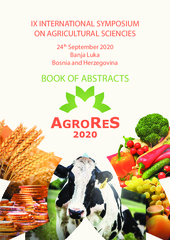Приказ основних података о документу
Genotype and fertilization effect on zinc content in maize (Zea mays L.)
| dc.creator | Đalović, Ivica | |
| dc.creator | Farooq, Muhammad | |
| dc.date.accessioned | 2021-11-01T11:52:51Z | |
| dc.date.available | 2021-11-01T11:52:51Z | |
| dc.date.issued | 2020 | |
| dc.identifier.isbn | 978-99938-93-63-9 | |
| dc.identifier.uri | http://fiver.ifvcns.rs/handle/123456789/2372 | |
| dc.description.abstract | Maize is a staple crop in many parts of the world, and is often targeted for micronutrient "biofortification”. Certain levels of micronutrients such as manganese (Mn), zinc (Zn) and iron (Fe) are necessary to mediate the numerous biochemical reactions essential for growth and development of the maize plant. The microelements content in grain is a complex trait affected by a number of factors, including genotype, soil properties, environmental conditions and nutrient interactions. This two-year field study was designed to evaluate the influence of different fertilizer combinations on zinc content in maize grain. Four divergent maize hybrids NS 4023, NS 6010, NS 6030 and NS 640 were grown under three fertilizers combinations. | sr |
| dc.language.iso | en | sr |
| dc.publisher | Banja Luka : University of Banja Luka, Faculty of Agriculture | sr |
| dc.rights | openAccess | sr |
| dc.rights.uri | https://creativecommons.org/licenses/by/4.0/ | |
| dc.source | Book of Abstracts, 9th International Symposium on Agricultural Sciences "AgroReS 2020", 24 September 2020, Banja Luka, Bosnia and Herzegovina | sr |
| dc.subject | genotypes | sr |
| dc.subject | fertilization | sr |
| dc.subject | maize | sr |
| dc.subject | zinc | sr |
| dc.subject | micronutrients | sr |
| dc.subject | hybrids | sr |
| dc.subject | Zn-efficient genotypes | sr |
| dc.title | Genotype and fertilization effect on zinc content in maize (Zea mays L.) | sr |
| dc.type | conferenceObject | sr |
| dc.rights.license | BY | sr |
| dc.citation.epage | 30 | |
| dc.citation.spage | 30 | |
| dc.identifier.fulltext | http://fiver.ifvcns.rs/bitstream/id/6420/bitstream_6420.pdf | |
| dc.identifier.rcub | https://hdl.handle.net/21.15107/rcub_fiver_2372 | |
| dc.type.version | publishedVersion | sr |


